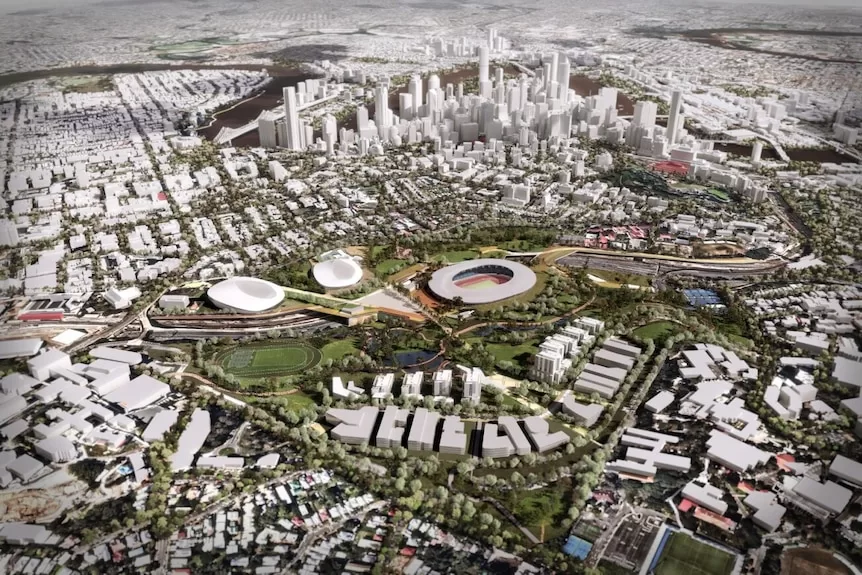It really, really shouldn’t have been this hard.
Back in July 2021, when Brisbane was “picked” to host the 2032 Olympics – or carefully engineered by the International Olympic Committee (IOC) to be the inevitable winner of a one-city race – the subtropical city had a massive head start with an unprecedented 11 years to prepare.
Loading…
But more than 900 days later, we are up to our third major plan for key venues.
At the start of this week, Queenslanders were treated to two radically different plans for how Brisbane might host the Olympics, in less than 24 hours.
Looking back, Monday’s dramatic about-face by Premier Steven Miles was arguably the inevitable result of two totally different visions for the Games that have been on a collision course for about a decade.
Loading…
The first vision is personified by former Liberal lord mayor Graham Quirk, known as the “father” of the Brisbane 2032 bid.
A few years ago, when explaining why he wanted Brisbane to host, members of the corporate audience remember him putting up a single PowerPoint slide showing a fast train and a dollar sign.
For Quirk — and many people in the business, sporting and disability sectors along with the broader community — hosting the Games is all about the legacy left behind when the athletes and spectators depart.
He dreamt of the Games being a catalyst for creating world-class public transport and sporting facilities, accessible for all, catapulting Brisbane into international city status – a destination fit for the 1.65 million people expected to relocate to the south-east corner of the state in the next 20 years.
The second vision for the Brisbane Games springs from the imagination of veteran sports administrator and IOC member, John Coates.
For Coates, getting the Olympics to Brisbane was unfinished business, following the city’s failed bid for the 1992 games.
A quick look at this awkward promotional video, produced to “sell” Brisbane to IOC members in the 1980s, offers strong hints as to why Barcelona won the hosting rights.
Loading…
Coates is a key architect of a new IOC funding framework that encourages host cities to produce low-cost events using existing facilities.
The so-called “new norm” is at once a promise to aspiring Olympic cities that they won’t go broke, as well as a bid to safeguard future games — because after 2032 the IOC is likely to receive a lot less cash when it renegotiates the next 16 years of international broadcasting rights.
The bottom line is, people simply aren’t glued to free-to-air TV like they used to be.
‘Great value games’
On Monday, those two visions collided.
In the morning, Quirk released the results of a 60-day $450,000 independent review of the Games venues, commissioned in January by the aging Labor government with a “whatever you say goes, Graham” vibe from the new premier.
Loading…
Unsurprisingly, Quirk went big. Forget about the Gabba – let’s build a new “green field” stadium at Victoria Park, on the northern edge of the city at a whopping cost of $3.4 billion.
But unbeknownst to Quirk, he’d already been outmanoeuvred. By Monday afternoon, the wily veteran sports administrator John Coate’s vision had won.
The state government had been quietly and secretly working behind the scenes to bring to life Coate’s proposal of a “great value games”.
Meaning no new Olympic stadium. Instead we will take the $2.7 billion earmarked for the redevelopment of the Gabba and upgrade three existing stadiums.
Most of the cash – $1.6 billion – would be spent on refurbishing the old QEII stadium in the marvellously named suburb of Nathan.
Whack some temporary seating in and chuck a fresh coat of paint on a place best known for hosting the opening ceremony of the 1982 Commonwealth Games.
I was a 15-year-old in the stands when “Matilda” the giant perspex kangaroo winked at Queen and country before her mechanical “pouch” opened to reveal 20 kids dressed in ‘roo suits who ran out to perform a “trampoline display”.
Brisbane in the 80s, eh?
Loading…
This is where the whole announcement starts to get a “back of the envelope” feel.
Under the Coates plan, the government would take one billion-odd dollars to upgrade Lang Park (Suncorp Stadium) for the opening and closing ceremonies, and then tart up the Gabba.
The latter is a venue with too many shortcomings to properly catalogue, but here are a few: it doesn’t comply with disability requirements, ambulances can’t enter the field due to height restrictions, there are no female change or toilet areas, and visiting AFL teams grumble endlessly about the dressing room facilities.
There is widespread scepticism from a weary population on whether this is indeed the final plan, particularly given the possibility of a change of government in Queensland at the October state election.
At that point, the newly-elected premier (whoever it is) will finally have to explain why we actually want to host these Games at a final cost of at least $7.1 billion.
Is it to host a “low-cost” party using existing facilities? Or to create a legacy for a town that aspires to be an international city?
There are 100 months until the opening ceremony and two state elections between now and then.
At some point, the question needs an answer.
